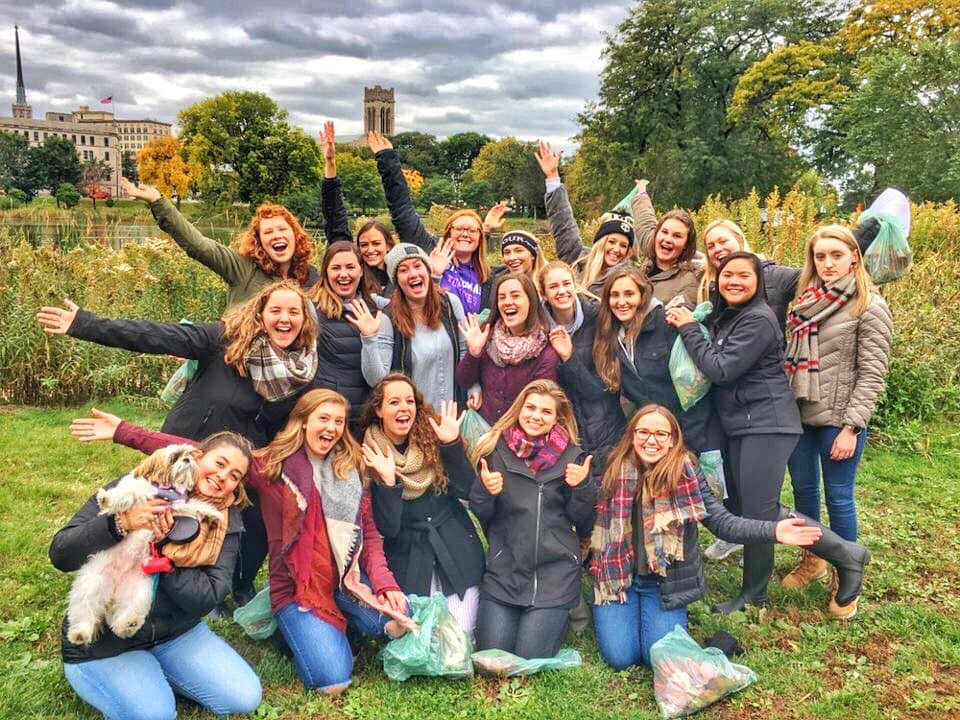The last few weeks have been a whirlwind for senior Sarah Kubes, who is majoring in teacher education. A student teacher at St. Thomas More Catholic School in St. Paul, Kubes has had to change the way she teaches her fourth-grade class because of COVID-19. Instead of working with her students face-to-face, she’s had to figure out ways to connect with them through distance learning tools.
“It’s new for all of us and it’s hard,” Kubes said. “But it’s a great learning experience for all of us student teachers and our students.”
Her cooperating teacher at St. Thomas More, Sue Wynne, said Kubes has risen to the challenge.
“Sarah has videoed herself teaching several math lessons, led a class video meeting and has had individual video check-ins with students,” Wynne said. “She also checks the work students are posting online. The kids know that she is there for them and they feel comfortable reaching out to her. She is doing many of the day-to-day activities of our remote learning situation, which is helping the kids keep a familiar routine and therefore feel connected and safe in this unusual time.”
Kubes said she’s comfortable with technology, so she volunteered to explore the different resources they’d need for distance learning, including Zoom, Seesaw and Google Docs. She hopes to continue using different forms of technology when she’s able to teach in person again. One of the most important lessons she’s learned during this time has been by watching how Wynne and other school leaders have dealt with this unprecedented situation.
“Seeing how everyone is handling everything is important to me, so I’ll know how to handle these types of situations in the future,” Kubes said.
Pivoting to distance learning
With schools across the country moving to online instruction during the COVID-19 pandemic, educators have scrambled to adapt their classes for distance learning. In Minnesota, public and charter K-12 schools will be using distance learning through at least April 30, with many private schools following suit. The School of Education's teacher education student teachers have been tapped to help with the transition. Some are also gathering educational opportunities for students that parents and educators can access through social media.
“Mr. Rogers is often quoted in times of crisis saying to children, ‘Look for the helpers.’ This lets children focus on the positive and to see that people are working together to help. This group of student teachers are amazing helpers!” said Amy Smith, associate professor and chair of the Department of Teacher Education at St. Thomas. “I couldn't be prouder of how they have jumped in to help their cooperating teachers prepare and teach remote lessons. In a matter of days, many of our student teachers were leading the way at some of their schools to create distance learning plans."
Student teachers were were able to pivot quickly and offer support at several points, Smith said, because:
- "Students’ technology integration happens throughout their coursework and provides students a foundation of current learning technologies."
- "Students have recorded themselves teaching at multiple points in their program, beginning sophomore year. They develop comfort and skill in recording teaching sessions and so this is not the first time they have used video for teaching."
- "Students have experienced significantly increased field hours throughout their programs, so they are well-prepared to teach."
- "Most importantly, our student teachers are excellent people. They understand the relational aspect of teaching and demonstrate professional dispositions that align with our St. Thomas mission and the cornerstones of the School of Education. They are ready to ‘Teach. Lead. Impact.’"

Current undergraduate teacher education students.
Sharing Resources
Seniors Ellie Davenport and Pame Portillo created a Facebook page where, along with their fellow St. Thomas student teachers, they’ve gathered educational resources for teachers and parents. There are posts with ideas for science and art projects, math games, stories read in English and Spanish, yoga videos for kids, virtual field trips and fun writing prompts.
Davenport works with second graders at Northpoint Elementary in Blaine. When the pandemic forced routines to change both at St. Thomas and Northpoint, she said she felt a sense of loss.
“Then I realized, what are our 6, 7, 8-year-olds feeling right now?” she said. “They don’t have their friends; they don’t have the resources to entertain themselves like adults do. I started to think about what we could do for these kids.
“I don’t know what the world is expecting of me right now or what the rest of my senior year is going to look like, but I’ve got this resource to contribute to on Facebook,” Davenport continued. “When I get down, the thing I want to do is serve someone else. That makes me feel like I have purpose. It makes me think of the St. Thomas motto, All for the Common Good.”
Portillo, from El Salvador, is passionate about bringing diversity to the classroom and enjoys teaching her kindergarten students at Community of Peace Academy in St. Paul about other cultures. Along with the many STEM activities she posts on Facebook, she also includes resources about diversity awareness.
“Sharing makes us feel like we’re adding a little bit of hope and help to the community, especially for those parents who are trying to keep their kids entertained,” she said.
Portillo is also working with her cooperating teacher on what class lessons will look like via Seesaw. “I’m throwing out my ideas, and they’re being heard. My mentor teacher has been a really good advocate for me.”
While both Davenport and Portillo are but are excited about creating a digital community through the Facebook page, they’re also missing in-person interactions with students. Davenport is looking forward to seeing how her students grow during their distance learning experience.
“This digital experience is going to bring on a wave of strong students who advocate for themselves because mom and dad might not know the kind of math they’re doing and they’re going to have to say, 'Ms. Davenport, I need help.’ And that’s such an incredible skill to develop,” Davenport said. “I can’t wait for my students to identify their needs.”
Finding support
Senior Molly Altermatt is a first-grade student teacher at Northpoint Elementary and has been involved with distance learning planning meetings. The pandemic has brought a lot of uncertainty, she said. She especially appreciates the support from her adviser at Northpoint, Anne Howard, along with those in her student teaching cohort.
“They are incredible human beings,” she said. “They are with me for life. We all feel the same emotions and are ready to offer support whenever needed.”
Davenport said while she and her peers are still processing the loss of their physical classrooms, she believes everyone is doing the best they can and feels supported by her mentors and the university. When she imagines being interviewed for teaching jobs in the future, she anticipates being asked how she reacted to the changes brought on by COVID-19.
"I'm really excited to be able to say that after the initial panic I was able to step up and create a role for myself and adapt,” she said. “I think that's one of the strongest qualities teachers need is the ability to adapt. You're always learning on your feet. In my future job, I'm excited to bring all the experience that I've had and the knowledge that people have poured into me. I could not have asked for a better school or a better cohort of women to share all their knowledge and their resources.”







